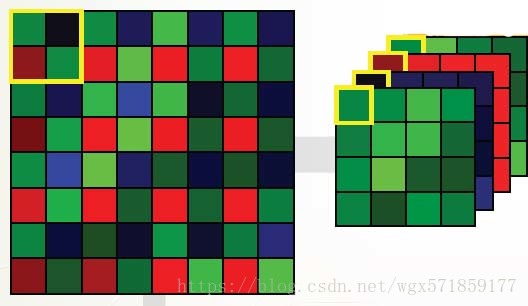今天遇到一个数组按照排布规律转变为4个数组的方法,通过转置与重塑在高维度实现,源代码如下:
def downsample_subpixel_new(x,downscale=2):
[b, h, w, c] = x.get_shape().as_list()
s = downscale
if h%s != 0 or w%s != 0:
print('!!!!Notice: the image size can not be downscaled by current scale')
exit()
x_1 = tf.transpose(x, [0, 3, 1, 2])
x_2 = tf.reshape(x_1, [b, c, h, w // s, s])
x_3 = tf.reshape(x_2, [b, c, h // s, s, w // s, s])
x_4 = tf.transpose(x_3, [0, 1, 2, 4, 3, 5])
x_5 = tf.reshape(x_4, [b, c, h // s, w // s, s * s])
x_6 = tf.transpose(x_5, [0, 2, 3, 1, 4])
x_output = tf.reshape(x_6, [b, h // s, w // s, s * s * c])
return x_output上面代码实现的效果为下图左边一个数组变为右边四个数组:

其中transpose为转置,数组相应维度进行交换
reshape重塑数组形状,从最后数组一维开始重塑,当维度较小时容易理解,维度超过三维时以下面例子直观展示:
为便于观察,假设开始时数组a为1到16的数字组成的维度为[1,4,4,1]的数组








 本文介绍了如何利用numpy库中的transpose和reshape函数,将一个高维度数组转换成四个独立的数组。通过具体的代码示例,详细解析了转置在交换数组维度的作用以及reshape在改变数组形状时的逻辑,特别是对于超过三维的数组重塑提供了直观的理解。
本文介绍了如何利用numpy库中的transpose和reshape函数,将一个高维度数组转换成四个独立的数组。通过具体的代码示例,详细解析了转置在交换数组维度的作用以及reshape在改变数组形状时的逻辑,特别是对于超过三维的数组重塑提供了直观的理解。
 最低0.47元/天 解锁文章
最低0.47元/天 解锁文章
















 838
838

 被折叠的 条评论
为什么被折叠?
被折叠的 条评论
为什么被折叠?








